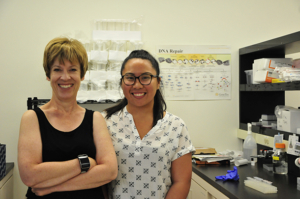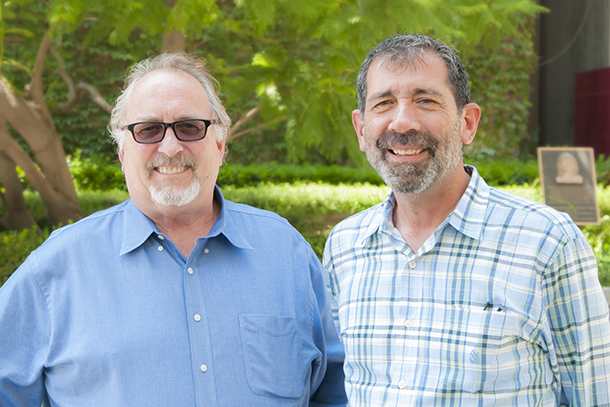Individually, the Science, Technology and Research (STAR) and Engineering for Health Academy (EHA) programs have long opened pathways for high school students — particularly underrepresented minorities — to pursue careers in life sciences, biomedical engineering and biotechnology.
Now, Daryl Davies, PhD, professor of clinical pharmacy and director of undergraduate education at the USC School of Pharmacy and Joseph Cocozza, PhD, assistant professor of research ophthalmology at the Keck School of Medicine of USC have joined to blend and expand these programs’ longstanding partnerships with Francisco Bravo Medical Magnet High School for even greater impact on young scientists’ futures.
The augmented STAR/EHA program, funded by USC’s Good Neighbors Campaign, offers an innovative approach to science, technology, engineering and math (STEM) education by providing high school students an entire year’s experience in USC research laboratories that is integrated with their academic curriculum.
Throughout the year, STAR/EHA students conduct original research projects under the careful guidance of postdoctoral researchers, graduate students, and laboratory directors. This level of engagement in a university-level research environment fosters the students’ interest in science and research, in addition to preparing them for success in college.
“I met people who helped me apply to college, taught me about college and graduate school, shared their experiences with me and supported me as I made decisions about my education,” said STAR alum Jenny Martínez, OTD, OTR/L, who now is an assistant professor at the USC Chan Division of Occupational Science and Occupational Therapy.

Bravo High senior Daniela Miranda, right, has been working in the laboratory of Paula Cannon, investigating mechanisms to improve the efficiency of gene editing. (Photo/Divya Yerwa Mary)
Students work in various biomedical and biomedical engineering labs in the Keck School, USC School of Pharmacy, Herman Ostrow School of Dentistry of USC and USC Viterbi School of Engineering. For example, Bravo High senior Daniela Miranda has been working in the laboratory of Paula Cannon, PhD, professor of molecular microbiology and immunology at the Keck School, investigating mechanisms to improve the efficiency of gene editing.
The experience, Miranda said, “made me realize I’m more capable than I thought I was.”
Cannon admits to initial skepticism about having a high school student join her lab, concerned that the science would be too intense. Today, she says it’s been a win-win experience.
“This isn’t a one-way thing,” she added. “We get so much back from it. Having the enthusiasm of a high school student brought out the best in my lab.” Through the eyes of young, aspiring scientists like Miranda, Cannon said, “you rediscover the excitement and incredible opportunity we have to do research every day.”
Community Partners in Building Futures
The STAR program and Bravo High have had a strong relationship since the school opened adjacent to the Health Sciences Campus in 1990. Vassilios Papadopoulos, DPharm, PhD, dean of the USC School of Pharmacy, notes that the STAR program, led for many years by USC School of Pharmacy Professor Roberta Diaz Brinton, PhD, is a vital part of the university’s mission to inspire and uplift the community.
“The USC School of Pharmacy has been the hub for the STAR program since its inception and the program’s success has been recognized nationwide,” Papadopoulos said.
Its sibling, EHA, has been in place for a decade. “By combining the strengths of both programs, STAR/EHA complements Bravo’s curriculum focused on medical careers and enables unique opportunities for students,” said Davies, who directs the revamped initiative. He noted, “Bravo has also been receiving greater attention and recognition for its outstanding performance as a LAUSD school.”
USC has become an active partner in the annual Bravo Health Science Fair, where STAR/EHA students make their final research presentations. “During the year, students report their research progress through a series of presentations attended by faculty, graduate student mentors and peers,” Cocozza said. “It enables them to make a compelling presentation at the annual science fair, where judges pick the best projects and give students the opportunity to present at the Los Angeles County Science Fair,” he added.
On their own, the STAR/EHA programs have had a 100 percent success rate of participants going on to college, with a large percentage attending top universities such as USC, Stanford, Caltech, Princeton, Yale, Harvard, MIT, Cornell, Brown and University of California, Berkeley. “This accelerated experience makes our students highly preferred candidates at top universities and over 95 percent of them receive scholarships,” Davies said.
Not only are Davies and Cocozza working with Bravo High to increase the number of students reached by STAR/EHA, but they also plan to expand its model to other high schools near USC.
From there, they see no limit to the program’s potential growth. Through their demonstrated success, Cocozza said, “We hope other universities are inspired to use this model and help high school students in their communities succeed.”
Yang Chai, DDS, PhD, professor and associate dean of research at the Ostrow School and director of the Center for Craniofacial Molecular Biology, has partnered with outreach programs including STAR since 1991. “A lot of high school students who come in to our labs are first-generation. They get to see exactly what it is to be a scientist and how to do research. Our hope is that it peaks an interest toward a career in the sciences. If we can help someone decide early on what they want to do or event not want to, that’s very helpful,” Chai said.
Davies makes sure to share credit for STAR/EHA’s championship of budding scientific talent. “Our faculty, graduate students and postdoctoral fellows have been instrumental in the success of these programs,” he said. “Their dedication to see these high school students succeed has paid off year-in, year-out.”
— Divya Yerwa Mary


